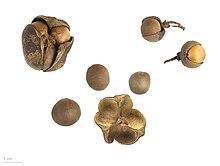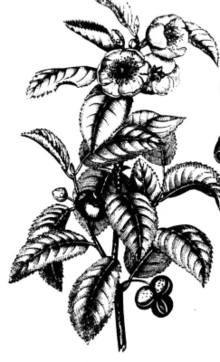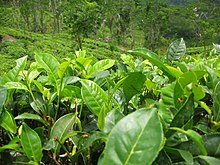Tea (plant)
| tea | ||||||||||||
|---|---|---|---|---|---|---|---|---|---|---|---|---|
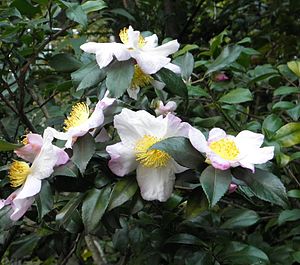
Branches of a tea plant with opened flowers. |
||||||||||||
| Systematics | ||||||||||||
|
||||||||||||
| Scientific name | ||||||||||||
| Camellia sinensis | ||||||||||||
| ( L. ) Kuntze |
The tea plant ( Camellia sinensis ) is a species of the genus Camellia ( Camellia ) within the tea bush family (Theaceae). Real tea is obtained from the parts of the plant .
description
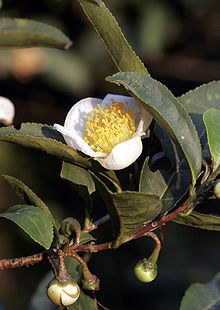
The Camellia sinensis varieties grow as evergreen shrubs or small trees with heights of 1 to 5, rarely up to 9 meters. The bark of young twigs is initially reddish in color and covered with white hairs, but it quickly becomes bare and turns yellowish-gray. The end buds are also silvery hairy.
The alternate leaves arranged on the branches are divided into a petiole and a leaf blade. The petiole is short. The simple leaf blade is round to elongated-elliptical with a length of 5 to 14 centimeters and a width of 2 to 7.5 centimeters with a wedge-shaped blade base and blunt upper end, which has an indicated trickle tip . The leaf margin is serrated. The upper side of the leaf is dark green, smooth and shiny. The underside of the leaf is lighter in color and may be hairy. In addition to the midrib, there are seven to nine leaf veins on each side, from which further reticulated leaf veins branch off. The leaf veins are equally visible and protruding on the top and bottom of the leaf.
From October to February the flowers appear singly or in threes in the leaf axils. Under each stalked flower there are two bracts that fall off early. With a diameter of 2.5 to 3.5 centimeters, the radially symmetrical flowers are hermaphroditic with a double flower envelope . The inside of the five sepals is usually hairy. The six to eight white petals are arranged in two circles, the outer one to three resemble the sepals, the inner ones are fused together at their base. The many stamens are arranged in four or five circles, those of the outer circle are fused together at the base. The ovary is usually hairy. The approximately 1 centimeter long stylus ends in a three-lobed scar .
The capsule fruit is flattened and contains one or two brown, rounded seeds . They ripen from August to October.
The number of chromosomes is 2n = 30.
Systematics
It was first published in 1753 under the name (Basionym) Thea sinensis by Carl von Linné in Species Plantarum , 1, p. 515. A new combination was carried out in 1887 by Kuntze in Trudy Imperatorskago S.-Peterburgskago Botaničeskago Sada , 10, p. 195; he placed them under the name Camellia sinensis in the genus Camellia .
Camellia sinensis belongs to the Thea (L.) Dyer section in Hook. within the genus of Camellia .
There are four varieties within the species Camellia sinensis :
- Camellia sinensis ( L. ) Kuntze var. Sinensis , also called China seed plant, comes from the southern Chinese highlands, thrives at altitudes of up to 2500 meters and can withstand brief frosts. It grows as a shrub that reaches heights of 6 to 8 meters. The plant can live to be 120 to 140 years old. The underside of the leaves and the outside of the sepals are hairless, the tip of the leaf blunt. Widely used by cultivation.
- Camellia sinensis var. Assamica (JWMasters) Kitamura , also called Assam seed plant, thrives particularly well on the plains and in marshland and becomes tree-like about 18 meters high. The origin is not known exactly, but it is suspected in the triangle between Burma , Bangladesh and Assam , where the tree also grows wild, but southern China is also under discussion. - Large leaves with hairy underneath. South China and India .
- Camellia sinensis var. Dehungensis (Hung T. Chang & BHChen) TLMing - leaves are even larger than those of var. Assamica , hairy on the underside, hairless ovaries. Widespread in southern Yunnan .
- Camellia sinensis var. Pubilimba Hung T. Chang - The underside of the leaves and the outside of the sepals are hairy. Widespread in Southeast China.
distribution
The distribution area of the Camellia sinensis varieties extends from southern Japan and Korea across the southern half of China to northeastern India ( Camellia sinensis var. Assamica ). To the south, Camellia sinensis is even more widespread to Laos , Myanmar , Thailand and Vietnam . It grows in the undergrowth of evergreen laurel forests (Camellietea japonicae Miyw. & Ohnab 63). Due to the long period of human use, the natural area can no longer be precisely determined.
The Camellia sinensis varieties thrive in the wild in a subtropical monsoon climate with humid, hot summers and relatively dry, cool winters. Areas with severe frosts are also populated in northern locations (vid. Clifford Parks).
Economical meaning
The largest tea producers
According to the FAO, 6.4 million tons of tea were harvested worldwide in 2018 . The world's ten largest tea producers together harvested 90.5% of the total in 2018.
| rank | country | Quantity (in t ) |
|---|---|---|
| 1 |
|
2,610,400 |
| 2 |
|
1,344,827 |
| 3 |
|
492.990 |
| 4th |
|
303.840 |
| 5 |
|
270,000 |
| 6th |
|
270,000 |
| 7th |
|
141,342 |
| 8th |
|
109,357 |
| 9 |
|
109,357 |
| 10 |
|
83.052 |
| world | 6,337,969 |
trade
see tea # The largest tea exporters
use
Main items: tea , green tea , black tea , white tea , oolong
From the cultivars of two Camellia sinensis varieties, different types of tea are produced in terms of quality: Camellia sinensis var. Sinensis produces a light, light tea with a lot of aroma, while Camellia sinensis var. Assamica produces a strong and dark tea. The yields of Camellia sinensis var. Assamica are significantly higher. For tea production, crosses of these two varieties, which are grown from cuttings, are also used.
From parts of the tea plant (leaves, leaf buds, stems) a hot infusion drink is made , the tea is prepared. Tea has a history that goes back many thousands of years and goes back to antiquity (see tea route ).
Camellia oil is obtained from the seeds .
Use as a remedy
Serve as a medicinal drug:
- Black tea, the wilted, rolled leaves are used, in which the enzyme phenol oxidase can escape and initiate fermentation . This takes place over a few hours at high humidity when the leaves are spread out in a thin layer. After that, the process is stopped with hot air and the leaves are dried.
- Green tea, the leaves are heat-treated immediately after harvest and then dried. The enzyme phenol oxidase is inactivated so that the leaves remain largely green.
Active ingredients:
- In black tea, methylxanthines such as caffeine (up to 4%), partly bound to tannins , in small amounts theophylline and theobromine ; Catechins , including flavanols , which are oxidized to theaflavins and thearubigenes during fermentation and which are responsible for the color and taste of the tea infusion; furthermore flavonols and their glycosides such as kaempferol and myricetin , oligomeric proanthocyanidins , theanine ; over 300 volatile flavors such as theaspirans , which are responsible for the earthy aroma; Aluminum and magnesium compounds and fluorides in remarkable concentrations.
Applications:
- Because of its stimulating effect and its high caffeine content, black tea is more of a stimulant than a medicinal product. The use due to the tannin content for mild diarrhea and upset stomach is well known in folk medicine . A bacteria-inhibiting effect on various diarrhea pathogens has also been proven. The high fluoride content has a preventive effect against tooth decay and osteoporosis .
- The green tea is said to have further effects: Due to the different treatment of the starting material, the caffeine content is lower (on average 2.2%). However, the polyphenol content is significantly higher, especially the epigallocatechin gallate, which is probably the most important substance, even has five times the value in unfermented tea.
Studies indicate a cancer-preventing and cardiovascular disease, such as arteriosclerosis , protective effect, which is mainly attributed to the potential of these phenolic ingredients in green tea to act as radical scavengers . The amount of tea that is said to produce these health effects is stated differently and is between 4 and 10 cups per day. We warn against exaggerated expectations of being able to practice cancer prophylaxis with green tea. Definitive proof of effectiveness is still pending.
Cultivation
The tea plants have traditionally been in two varieties cultivated: as Camellia sinensis var. Sinensis (strauchwüchsiges, kleinblättriges, cold-resistant highland plant) mainly in China and Darjeeling , while until 1830 in Assam discovered baumwüchsige Camellia sinensis var. Assamica (fast-growing, large-leaved than the variety Camellia sinensis var. Sinensis ) dominated the rest of India and Sri Lanka , for example . These two pure varieties are increasingly being pushed back by hybrids worldwide.
The tea plant is cultivated in the subtropics and in the tropics, there especially in high altitudes. Both green and black tea are mainly produced in Asia , but also in Africa , America, Australia and even in Europe (the Azores and Turkey). The most important tea-producing countries are China, India, Kenya , Sri Lanka and Turkey, which together account for around three quarters of world production. According to its own statement, Japan only produces green teas . Black tea for own consumption is imported. Although tea is almost exclusively harvested by machine in Japan, the quality of many Japanese green teas is of the highest quality. This is related to the very old Japanese traditions in which tea is seen as a mediator between art, philosophy and way of life ( Japanese tea ceremony ). Quality green teas continue to come from China, but only in small quantities, as these teas are made exclusively by hand. Therefore, they are so expensive that they can be used as gifts for special guests of state.
The most important importing countries are Great Britain , Russia , Pakistan , the USA and the Arab states.
According to the German Tea Association , in which most of the companies in the German tea trading and processing industry are organized, the German annual consumption of tea in 2014 was 19,176 t or almost 27.5 l of tea per capita. Germany is also an important location for tea processing: almost half of the tea imported was exported again in 2014.
Well-known growing areas
Well-known tea-growing areas, after which the varieties produced there are named
- Darjeeling - known as the queen of teas; comes from northeast India at an altitude of about 2000 m, southern slopes of the Himalaya - light, fine, aromatic
- Ceylon - Sri Lanka - rounder, finer, tangy tea with copper-red cup, a standard part of many tea blends ( Blend )
- Assam - North India, plateau on Brahmaputra - strong, dark, malty-spicy, in addition to high-quality single lots (pure unmixed plantation teas), Second Flush Assams form the basis for the East Frisian and many other blends and have shaped the tea habits of many nations (especially in Germany East Frisia, Ireland, also England and Russia)
- Japan - from here come the fine, noble Senchas ; the somewhat cooler climate gives it its special touch. The dark green Gyokuro and other shade and partial shade teas also come from Japan , for which the tea leaves are grown in the shade or partial shade for a few weeks. These teas fetch the highest prices in the world. The powdered tea, matcha , which is used for the artful tea ceremony, is even more valuable
- Formosa (the former name of Taiwan) - above all high-quality “oolongs”, especially popular in the USA, also pouchong , lightly fermented tea, and particularly heavily smoked teas, such as tiger tea or crocodile Lapsang Souchong
- Yunnan - China - flowery, natural, whether as green tea, semi-fermented or black tea. Another specialty from Yunnan is pu-erh tea , which is post-fermented and is usually sold as flat cakes or pressed into a nest. There is “Pu Erh” that is up to 80 years old and that ripens and becomes more and more valuable
- Bengal - Bangladesh - delicate, large-leaved, an ideal breakfast tea.
- Rize - Northeast Turkey, Lasian farmers, black tea, pleasantly light quality
- Hangzhou - China - flowery, of course, only as green tea
- Africa - Mozambique , Kenya, Zimbabwe , Cameroon , predominantly simple qualities that are mostly lost in the mixes of the large trading companies. Only from Kenya do small quantities of hand-picked, high-quality leaf teas come, which, similar to Ceylons, often have a fresh citrus note
- Java - Indonesia - light and fruity
- Sumatra - Indonesia - harvest all year round, good everyday tea
- Georgia but not with the good Alltagstee - Russian tea to be confused - even caravan tea called
- Brazil - Japanese tea production, promising successes
harvest
Tea is harvested every 6 to 14 days throughout the growing season. The best qualities are still harvested almost exclusively by hand. Tea picking is a craft that requires considerable experience and is mostly practiced by women. With top teas, only the bud of each shoot with two leaves is harvested ( two leaves and a bud ). Approx. 8 kg of fresh tea leaves have to be picked for 1 kg of finished black tea. Mechanical harvesting methods are often used to produce simple types of tea. Japanese tea production is an exception - high-quality teas are also harvested here by machine. The harvest and production process has been perfected to such an extent that cut tea leaves for varieties such as B. Gyokuro can be used.
Depending on the location of the cultivation area, there are continuous or only monthly harvest times. The time of picking affects the color and taste of the tea. In Darjeeling, Sikkim , Nepal and other regions of the Himalayas there are distinct seasons, there the teas for trade and marketing are also named after the picking period:
-
First Flush is picked in spring from March to mid-April and is fresh and tangy, characterized by young shoot tips. These teas are usually of high quality, but lose their fresh aroma after a few months and should therefore not be stored for long.
- Flight tea is a very early harvested first flush that comes to the consumer as air freight immediately after processing and should be used quickly.
- In Between is harvested from April to mid-May. In terms of taste, these teas are usually not very pronounced and are also used for stretching.
- Second Flush is picked in summer from May to June and is a strong aromatic tea with a spicy aroma. Second flush teas are among the highest quality teas, they retain their aroma for a long time when stored. Then the so-called "regenteas" are harvested, teas with insignificant taste that are only used for blends or simple teas - or to keep the harvest and sales quantities stable.
- Autumnal is harvested in autumn in October and November. It is no longer necessarily one of the high-class teas, but has a distinctive, full-bodied character. It owes its softness to the reduced tannin content.
Diseases
The naked basid Exobasidium vexans attacks the leaves.
literature
- Min Tianlu, Bruce Bartholomew: Camellia sinensis. P. 376 - online with the same text as the printed work , In: ZY Wu, PH Raven (Ed.): Flora of China. Volume 12, Missouri Botanical Garden Press, St. Louis 2007, ISBN 978-1-930723-64-1 .
- Henry Hobhouse: Six plants change the world. Cinchona bark, sugar cane, tea, cotton, potato, coca bush. 4th edition. Klett-Cotta, Hamburg 2001, ISBN 3-608-91024-7 , 401 pages (exciting story to read with a completely different perspective).
- Aleijos: Green wonder drug tea. Wilhelm Braumüller Verlag, 1998, ISBN 3-7003-1217-2 (good overview, somewhat dry, old sources, very questionable last part, including a polemic against fermented tea).
- Otto F. Schleinkofer: The tea. Munich 1924. 3rd edition. de Gruyter, Berlin 1982, ISBN 3-11-009179-8 .
- Hans G. Adrian, Rolf L. Temming, Arend Vollers: The tea book. History and stories. Cultivation, production and recipes ISBN 3-928127-01-2 (very good, but sometimes used unrestrainedly in previous works),
- Jane Pettigrew: Tea. Benedikt Taschen Verlag, Cologne 1998, ISBN 3-8228-7595-3 (reprinted in 2002 by Gondrom Verlag ISBN 3-8112-1701-1 ).
- Ernst Janssen: Janssen's Tea Almanac. 2003, ISBN 3-927359-85-8 , 288 pages (extensive compendium on everything to do with tea, clears up some misunderstandings by introducing more recent nutritional knowledge: review ).
Web links
- The tea bush - Camellia sinensis at giftpflanze.com .
- German Tea Association V.
- Specialized information on the transport of tea. Transport information service
Individual evidence
- ↑ a b c d e f g Min Tianlu, Bruce Bartholomew: Camellia sinensis. P. 376 - online with the same text as the printed work , In: ZY Wu, PH Raven (Ed.): Flora of China. Volume 12, Missouri Botanical Garden Press, St. Louis 2007, ISBN 978-1-930723-64-1 .
- ↑ Camellia sinensis at Tropicos.org. In: IPCN Chromosome Reports . Missouri Botanical Garden, St. Louis
- ↑ First publication scanned at botanicus.org .
- ^ Erich Oberdorfer : Plant-sociological excursion flora for Germany and neighboring areas. 8th edition. Verlag Eugen Ulmer, Stuttgart 2001, ISBN 3-8001-3131-5 .
- ↑ a b Crops> Tea. In: FAO production statistics for 2018. fao.org, accessed on March 23, 2020 .
- ↑ Rainer Schmidt: Tea the guide for connoisseurs and connoisseurs. Heyne, 1997, ISBN 978-3-453-11526-2 , pp. 12-14.
- ↑ a b c d e f Ingrid and Peter Schönfelder : The new book of medicinal plants . Franckh-Kosmos Verlag, 2011, ISBN 978-3-440-12932-6 .
- ↑ a b German Tea Association : Tea as an Economic Factor ( Memento of the original from December 21, 2015 in the Internet Archive ) Info: The archive link was inserted automatically and has not yet been checked. Please check the original and archive link according to the instructions and then remove this notice. (PDF, as of May 2015).
- ↑ C. Booth: Exobasidium vexans. In: CMI Descriptions of Pathogenic Fungi and Bacteria. Volume 779, 1983.
